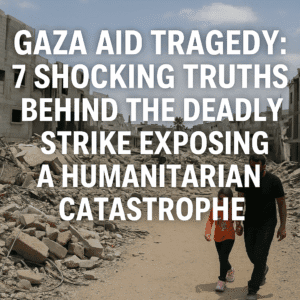Gaza Aid Tragedy: 7 Shocking Truths Behind the Deadly Strike Exposing a Humanitarian Catastrophe
A devastating Israeli tank attack killed at least 51 Palestinians and wounded hundreds in Gaza on Tuesday as desperate crowds gathered for essential aid in Khan Younis. The Hamas-run health ministry reported severe hospital overcrowding, with critical patients lying on floors amid dire medical shortages. Witnesses described the scene as a “massacre,” with one survivor questioning, “Aren’t we human beings?” While the IDF acknowledged reports of civilian harm and stated it “regrets any harm” while reviewing the incident, this tragedy underscores the lethal reality facing civilians seeking basic survival. It follows Monday’s 34 deaths near aid sites, revealing a horrifying pattern where humanitarian access points become zones of extreme danger.
As the UN warns of 500,000 facing famine, the attack tragically illustrates how the struggle for food and medicine in Gaza now carries an intolerable risk of death, casting profound doubt on the effectiveness of current aid corridors and safety mechanisms.

Gaza Aid Tragedy: 7 Shocking Truths Behind the Deadly Strike Exposing a Humanitarian Catastrophe
In the pre-dawn hours of Tuesday, displaced Palestinians gathered near Khan Younis, drawn by the lifeline of an aid convoy. Hours later, 51 lay dead, hundreds wounded, and a hospital floor became a trauma ward. The incident—one of Gaza’s deadliest single-day civilian casualty events in months—exposes a brutal paradox: the struggle for humanitarian aid now carries lethal risks.
What We Know
- The Strike: Witnesses describe Israeli shells hitting crowds awaiting UN/commercial aid trucks. The IDF acknowledges firing after a “crowd’s approach” near troops, citing an “under review” investigation.
- The Aftermath: Nasser Hospital received “dozens of critical cases,” with patients strewn across floors due to overcrowding. Medical staff reported severe shortages of blood, anesthesia, and antibiotics.
- The Context: This follows Monday’s report of 34 Palestinians killed near aid distribution points—the highest daily toll since U.S.-backed aid corridors opened.
The Unspoken Crisis
- Aid as a Battleground:
Thanos Gargavanis (WHO trauma surgeon) notes a “constant correlation” between food distribution sites and mass casualties. When survival hinges on reaching aid convoys in active combat zones, civilians become targets by proximity.
- The Dignity Vacuum:
Samaher Meqdad’s cry—”Why did they fire? Aren’t we human beings?”—echoes beyond grief. With famine imminent (UN: 500,000+ food-insecure), the attack strips Palestinians of agency: Seeking bread risks death; staying silent guarantees starvation.
- Systemic Collapse:
Gaza’s health ministry warns of “severe overcrowding” in operating rooms. With 70% of hospitals nonfunctional, even those surviving strikes face a collapsed medical system.
The Global Response Gap
Hours before the attack, G7 leaders—including Donald Trump—called for a “ceasefire and de-escalation.” Yet as shells fell on Khan Younis, the disconnect between diplomatic rhetoric and ground reality widened.
The Unanswered Questions
- Why are aid corridors not demilitarized?
- How can “minimizing harm” (per IDF) align with tank fire in civilian queues?
- When will aid delivery prioritize safety over speed?
The Bottom Line: This isn’t merely a “tragic incident.” It’s the predictable outcome of a war where civilians, aid workers, and soldiers share the same shrinking spaces. Until aid distribution is decoupled from military operations, Gaza’s survival will remain a deadly gamble.
You must be logged in to post a comment.